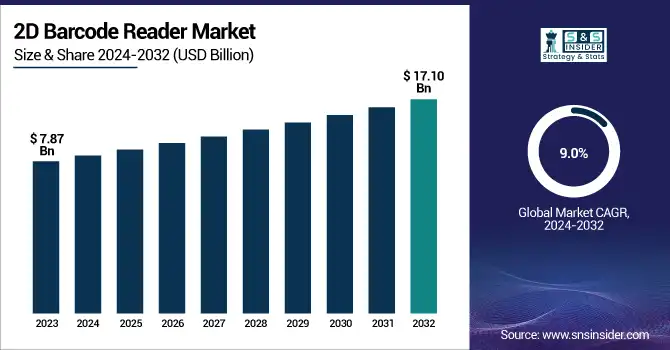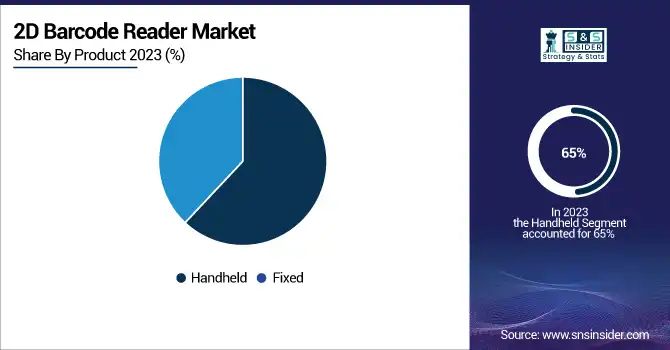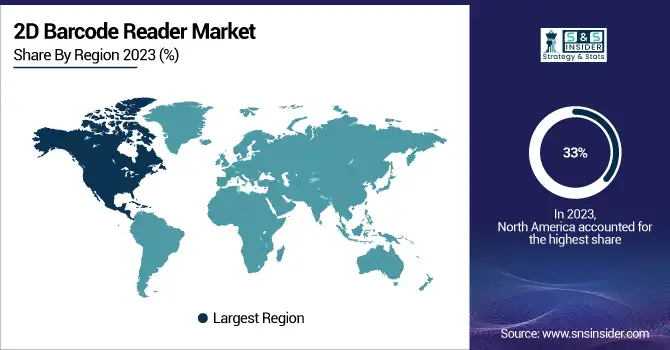2D Barcode Reader Market Size & Growth Trends:
The 2D Barcode Reader Market Size was valued at USD 7.87 Billion in 2023 and is expected to reach USD 17.10 Billion by 2032 and grow at a CAGR of 9.0% over the forecast period 2024-2032. The market is expanding rapidly due to rising logistics, retail, and manufacturing demand. Innovations in AI-powered scanning, cloud storage, and IoT integration have improved efficiency, while the transition from 1D to QR and data matrix codes has accelerated adoption. Growth is further fueled by warehouse automation, e-commerce expansion, and traceability regulations. Companies are developing AI-assisted vision systems, mobile scanning solutions, and ruggedized handheld devices to meet evolving needs. Additionally, the emergence of smartphone-based barcode scanning applications is reshaping the market, challenging traditional handheld scanners, and driving further technological advancements.

To Get more information on 2D Barcode Reader Market - Request Free Sample Report
2D Barcode Reader Market Dynamics
Key Drivers:
-
Increasing Automation and Smart Warehousing Solutions Driving the Growth of the 2D Barcode Reader Market
The rising adoption of automation and smart warehousing solutions is significantly driving the 2D barcode reader market. Industries such as logistics, e-commerce, healthcare, and manufacturing are increasingly relying on automated systems to improve efficiency, reduce errors, and enhance operational speed. 2D barcode readers play a crucial role in inventory management, tracking shipments, and enabling seamless data capture in real time. The integration of AI, machine vision, and IoT has further enhanced the performance of these scanners, making them indispensable for modern supply chain operations.
Additionally, the growing demand for contactless and high-speed scanning solutions is pushing companies to invest in rugged handheld scanners, fixed barcode readers, and smartphone-based barcode scanning applications. As businesses continue to streamline operations and adopt Industry 4.0 technologies, the demand for advanced 2D barcode readers will continue to surge, reinforcing their role in automated logistics and inventory management systems.
Restrain:
-
High Initial Investment and Integration Costs Restraining the Growth of the 2D Barcode Reader Market
Despite its growing adoption, the 2D barcode reader market faces challenges due to high initial investment and integration costs. Businesses, particularly small and medium enterprises (SMEs), often struggle with the financial burden of deploying advanced barcode scanning solutions. The transition from traditional 1D barcode systems to 2D barcode readers requires significant investment in hardware, software, and employee training, which can be a deterrent.
Additionally, integrating these devices into existing enterprise resource planning (ERP) and warehouse management systems (WMS) demands technical expertise and ongoing maintenance costs. The implementation of AI-powered barcode readers and IoT-enabled smart scanning solutions further increases expenses, making it difficult for cost-sensitive businesses to adopt these technologies. While larger corporations can absorb these costs, smaller enterprises may delay or avoid investing in advanced barcode solutions. Overcoming cost barriers through affordable pricing models and financing options will be crucial for wider adoption across industries.
Opportunities:
-
Rising Adoption of AI and Machine Vision Technologies Creating Growth Opportunities in the 2D Barcode Reader Market
The integration of AI and machine vision technologies in 2D barcode readers is opening new growth opportunities for market players. AI-powered barcode scanners enhance reading accuracy, speed, and adaptability, making them ideal for high-speed logistics and industrial automation. Machine vision-based barcode readers can decode damaged, low-contrast, or distorted barcodes, reducing scanning errors in fast-moving operations. This is particularly beneficial for industries such as healthcare, automotive, and e-commerce, where precision and efficiency are critical.
Additionally, AI-driven barcode readers can analyze scanned data in real time, enabling predictive analytics and improved inventory tracking. With the rise of autonomous warehouses, robotic picking systems, and AI-powered supply chains, the demand for intelligent barcode reading solutions is expected to surge. Companies investing in AI-enhanced barcode technology can gain a competitive edge by offering smart, self-learning scanners that optimize workflows and improve overall operational efficiency.
Challenges:
-
Cybersecurity and Data Privacy Risks Posing Challenges to the 2D Barcode Reader Market Growth
As businesses increasingly rely on cloud-based barcode scanning solutions and connected systems, cybersecurity and data privacy risks have emerged as significant challenges for the 2D barcode reader market. Barcode readers, especially those integrated with IoT and cloud platforms, collect and transmit vast amounts of sensitive business and consumer data. This makes them potential targets for cyberattacks, data breaches, and unauthorized access. Weak encryption protocols, outdated firmware, and unsecured network connections can expose companies to data theft and operational disruptions.
Industries such as healthcare, finance, and retail, which handle critical consumer information, face heightened security concerns when implementing cloud-based barcode solutions. To mitigate risks, companies must invest in robust cybersecurity measures, encrypted data transmission, and regular software updates. Additionally, regulatory compliance with data protection laws such as GDPR and HIPAA is essential for ensuring secure barcode scanning operations without compromising business or consumer privacy.
2D Barcode Reader Market Segments Analysis
By Product
Handheld Segment Dominated with 65% Revenue Share in 2023
The handheld segment held the largest revenue share of 65% in 2023 within the 2D barcode reader market, driven by its widespread adoption in retail, logistics, healthcare, and warehouse management. Handheld barcode readers offer portability, ease of use, and high-speed scanning, making them ideal for applications requiring mobility. Companies such as Honeywell, Datalogic, and Zebra Technologies have introduced rugged, AI-powered, and wireless handheld barcode scanners to cater to the growing demand for efficiency in inventory tracking and point-of-sale systems.
In 2023, Honeywell launched the Xenon Ultra 1960 series, an AI-enhanced handheld scanner designed to improve decoding speed and accuracy in high-volume environments. Similarly, Datalogic introduced the PowerScan 9600, which supports Bluetooth and Wi-Fi connectivity for seamless real-time data transmission.
Additionally, mobile-based barcode scanning applications, such as those by Scandit, have gained traction, offering cost-effective alternatives to traditional handheld devices. As industries continue to prioritize flexibility and workforce mobility, the demand for advanced, AI-integrated handheld barcode scanners will remain strong in the coming years.
The fixed segment of the 2D barcode reader market is projected to grow at the highest CAGR of 9.7% during the forecast period, driven by increasing adoption in factory automation, logistics, and high-speed manufacturing lines. Fixed barcode readers provide continuous, hands-free scanning, making them essential for automated production lines, robotic pick-and-place systems, and conveyor belt operations. With industries increasingly adopting robotic automation and smart warehousing, the demand for fixed 2D barcode readers is accelerating. The integration of machine vision, AI-enhanced reading capabilities, and IoT connectivity is transforming fixed scanners into intelligent data capture solutions, driving further growth in this segment.

By Application
The warehousing segment accounted for the largest revenue share in 2023 within the 2D barcode reader market, driven by the increasing adoption of automated inventory management systems and real-time tracking solutions. With the rapid expansion of e-commerce, omnichannel retail, and just-in-time inventory systems, warehouses rely heavily on high-speed, high-accuracy barcode scanning solutions to optimize operations. Companies such as Honeywell, Zebra Technologies, and Datalogic have launched ruggedized handheld and fixed barcode readers designed to withstand demanding warehouse environments. The integration of AI, IoT, and cloud-based tracking solutions in barcode readers has enhanced warehouse efficiency, reduced errors, and improved inventory accuracy. With the growth of smart warehouses and robotics-driven fulfillment centers, the demand for advanced 2D barcode readers will continue to rise, reinforcing their critical role in warehouse automation and real-time supply chain management.
The logistics segment is projected to grow at the highest CAGR in the forecast period, driven by the increasing need for real-time shipment tracking, automated sorting, and last-mile delivery optimization. The global surge in e-commerce, cross-border trade, and omnichannel distribution has heightened the demand for high-speed, AI-integrated barcode scanning solutions in logistics operations. Companies such as Cognex, Keyence, and SICK AG have introduced next-generation barcode readers tailored for logistics and supply chain automation.
Additionally, SICK AG introduced the Lector85x series, a fixed 2D barcode reader designed for automated sorting systems and conveyor belt operations. The adoption of AI-assisted vision systems and IoT-enabled tracking solutions is transforming logistics, enabling real-time data insights and predictive analytics. With logistics companies prioritizing efficiency, traceability, and cost reduction, the demand for advanced 2D barcode readers will continue to accelerate, driving growth in this segment.
2D Barcode Reader Market Regional Outlook
In 2023, North America dominated the 2D barcode reader market, holding an estimated market share of over 33%, driven by high adoption rates across retail, logistics, healthcare, and industrial automation. The region's strong presence of leading technology providers such as Honeywell, Cognex, and Zebra Technologies has contributed significantly to market growth. North America’s advanced warehousing infrastructure, e-commerce boom, and increasing automation in supply chain management have fueled demand for high-performance 2D barcode readers. For example, in 2023, Honeywell introduced the Xenon Ultra 1960 series, enhancing barcode scanning speed and accuracy in retail and warehouse settings.
Additionally, Amazon and Walmart have integrated AI-powered barcode readers into their fulfillment centers, streamlining inventory tracking and order processing. The region’s stringent regulatory requirements for traceability in pharmaceuticals and food safety have further boosted adoption. With continued investments in AI-driven scanning solutions and IoT-enabled warehouse management, North America is expected to maintain its dominance in the coming years.
Asia-Pacific emerged as the fastest-growing region in the 2D barcode reader market in 2023, with an estimated CAGR of 10.2% during the forecast period. The region’s rapid industrialization, expanding e-commerce sector, and rising adoption of smart manufacturing solutions are key growth drivers. Countries like China, Japan, and India are witnessing increased demand for AI-integrated barcode readers in warehousing, logistics, and retail. In 2023, Keyence launched the SR-X series, featuring deep learning algorithms for high-speed barcode decoding, catering to smart factories and automated production lines in the region. Similarly, Alibaba and JD.com have heavily invested in AI-powered warehouse automation, leveraging fixed and handheld barcode scanners for seamless inventory management.
The growing emphasis on digitalization and government initiatives supporting smart logistics in Asia-Pacific further accelerate market expansion. As businesses continue to adopt advanced barcode scanning technologies to improve supply chain efficiency, the region is expected to experience sustained high growth.

Get Customized Report as per Your Business Requirement - Enquiry Now
Key Players
Some of the major players in the 2D Barcode Reader Market are:
-
Casio Computer Co., Ltd. (DT-X400 Handheld Terminal, IT-G600 Barcode Scanner)
-
Cognex Corp. (DataMan 8700 Handheld Barcode Reader, In-Sight 2D Vision Systems)
-
Datalogic S.p.A. (Matrix 320 Fixed Scanner, PowerScan 9600 Handheld Scanner)
-
Denso Wave Inc. (QB30 Fixed Scanner, BHT-M Series Handheld Terminal)
-
General Data Company, Inc. (GDC 2D Barcode Scanner, TSC Alpha-4L Mobile Printer with Barcode Scanner)
-
Honeywell International, Inc. (Xenon Ultra 1960 Handheld Scanner, Vuquest 3320g Fixed Barcode Scanner)
-
JADAK - A Novanta Company (FM-5 Fixed-Mount Barcode Reader, HS-1 Handheld Scanner)
-
Juniper Systems Inc. (Mesa 3 Rugged Tablet with Barcode Scanner, Cedar CP3 Handheld Computer)
-
Keyence Corp. (SR-2000 Series Fixed Barcode Reader, BT-W300 Handheld Terminal)
-
Marson Technology Co., Ltd. (MT8220 2D Handheld Scanner, MT6225 Fixed Barcode Reader)
-
Omron Microscan Systems, Inc. (MicroHAWK ID-40 Fixed Barcode Reader, V420-F 2D Handheld Scanner)
-
Sato Holdings Corp. (CL4NX Plus Barcode Printer with Scanner, PW208NX Mobile Printer with Barcode Scanner)
-
Scandit (Scandit Barcode Scanner SDK, MatrixScan Augmented Reality Scanner)
-
SICK AG (Lector85x 2D Fixed Scanner, IDM26x Handheld Barcode Reader)
-
Unitech Electronics Co., Ltd. (MS852 2D Handheld Scanner, TS100 Fixed Barcode Scanner)
Recent Trends
-
In October 2023, Cognex Corporation introduced the DataMan 380 series, a fixed-mount, image-based barcode reader. Equipped with a CMOS sensor offering up to 16.13 MP resolution, this reader features AI-accelerated decoding to enhance throughput by simultaneously processing 1D and 2D codes.
| Report Attributes | Details |
|---|---|
| Market Size in 2023 | USD 7.87 Billion |
| Market Size by 2032 | USD 17.10 Billion |
| CAGR | CAGR of 9.0% From 2024 to 2032 |
| Base Year | 2023 |
| Forecast Period | 2024-2032 |
| Historical Data | 2020-2022 |
| Report Scope & Coverage | Market Size, Segments Analysis, Competitive Landscape, Regional Analysis, DROC & SWOT Analysis, Forecast Outlook |
| Key Segments | • By Product (Handheld, Fixed) • By Application (Warehousing, E-commerce & Retail, Logistics, Factory Automation) |
| Regional Analysis/Coverage | North America (US, Canada, Mexico), Europe (Eastern Europe [Poland, Romania, Hungary, Turkey, Rest of Eastern Europe] Western Europe] Germany, France, UK, Italy, Spain, Netherlands, Switzerland, Austria, Rest of Western Europe]), Asia Pacific (China, India, Japan, South Korea, Vietnam, Singapore, Australia, Rest of Asia Pacific), Middle East & Africa (Middle East [UAE, Egypt, Saudi Arabia, Qatar, Rest of Middle East], Africa [Nigeria, South Africa, Rest of Africa], Latin America (Brazil, Argentina, Colombia, Rest of Latin America) |
| Company Profiles | Casio Computer Co., Ltd., Cognex Corp., Datalogic S.p.A., Denso Wave Inc., General Data Company, Inc., Honeywell International, Inc., JADAK - A Novanta Company, Juniper Systems Inc., Keyence Corp., Marson Technology Co., Ltd., Omron Microscan Systems, Inc., Sato Holdings Corp., Scandit, SICK AG, Unitech Electronics Co., Ltd. |

